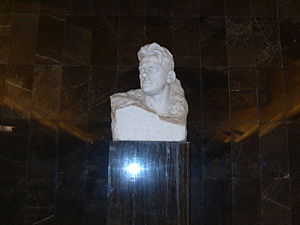- Mayakovskaya (Moscow Metro)
-
For other uses, see Mayakovsky.
Mayakovskaya

Moscow Metro station
Bust of Mayakovskiy on the vestibuleStation statistics Coordinates 55°46′12″N 37°35′45″E / 55.77°N 37.59583°E Lines  Zamoskvoretskaya Line
Zamoskvoretskaya LineConnections Bus: 12ts
Trolleybus: 1, 3, 12, 47Depth 33 metres (108 ft) Levels 1 Platforms 1 island platform Tracks 2 Parking No Bicycle facilities No Baggage check No Other information Opened 11 September 1938 Code 034 Owned by Moskovsky Metropoliten Formerly Triumfalnaya ploshchad, Ploshchad Mayakovskogo Traffic Passengers (2002) 17,465,250 Services Preceding station Moscow Metro Following station Belorusskayatoward Rechnoy VokzalZamoskvoretskaya Line Tverskayatoward KrasnogvardeyskayaMayakovskaya (Russian: Маяковская), is a Moscow Metro station on the Zamoskvoretskaya Line. Considered to be one of the most beautiful in the system, it is one of the finest examples of pre-World War II Stalinist Architecture making it one of the most famous Metro stations in the world. The name as well as the design is a reference to Futurism and its prominent Russian exponent Vladimir Mayakovsky.
History
The station was built as part of the second stage of the Moscow Metro expansion, and was opened on 11 September 1938. If the first stage was more focused on the building the system itself, both architecturally and engineeringly the stations appear modest in comparison to those that the second stage brought to the system. For the first time in the world, instead of having the traditional three-neath pylon station layout, the engineers were able to overlap the vault space and support it with two sets of colonnades on each side. This gave birth to a new column type design and Mayakovskaya was the first station to show this.
Located 33 meters beneath the surface, the station became famous during World War II when an air raid shelter was located in the station. On the anniversary of the October Revolution, on 7 November 1941 Joseph Stalin addressed a mass assembly of party leaders and ordinary Muscovites in the central hall of the station.
Design
If the triumph in engineering was not enough, then Alexey Dushkin's brilliant Art Deco decoration design was truly amazing. Based on Soviet future as envisioned by the famous poet Mayakovsky the station features graceful columns faced with stainless steel and pink rhodonite, white Ufaley and grey Diorite marble walls, a brilliant flooring pattern of white and pink marble, and of course, most of all are the niches of each of the 35 niches of each vault. Surrounded by filament lights there are a total of 34 brilliant ceiling mosaics by Alexander Deyneka with the theme "24-Hour Soviet Sky." A passenger has but to look up and see the bright Soviet future in the heavens above him.
In 2005 a new second north exit was built along with a new vestibule in a unique style. Passengers leaving the station will first descend on a short escalator ride into an underground vestibule and only then climb the long one to the surface. The new exit also allowed access to the 25th mosaic, which was previously hidden behind the service section. Other mosaic works were designed from scratch, accompanied by ample use of marble and stainless steel sculpturing. The bust of the poet was moved to the new surface vestibule whose ceiling was also decorated with a mosaic composition from Mayakovski's poem "Moscow Sky".
Categories:- Moscow Metro stations
- Stalinist architecture
- Colonnades
- Railway stations opened in 1938
Wikimedia Foundation. 2010.



